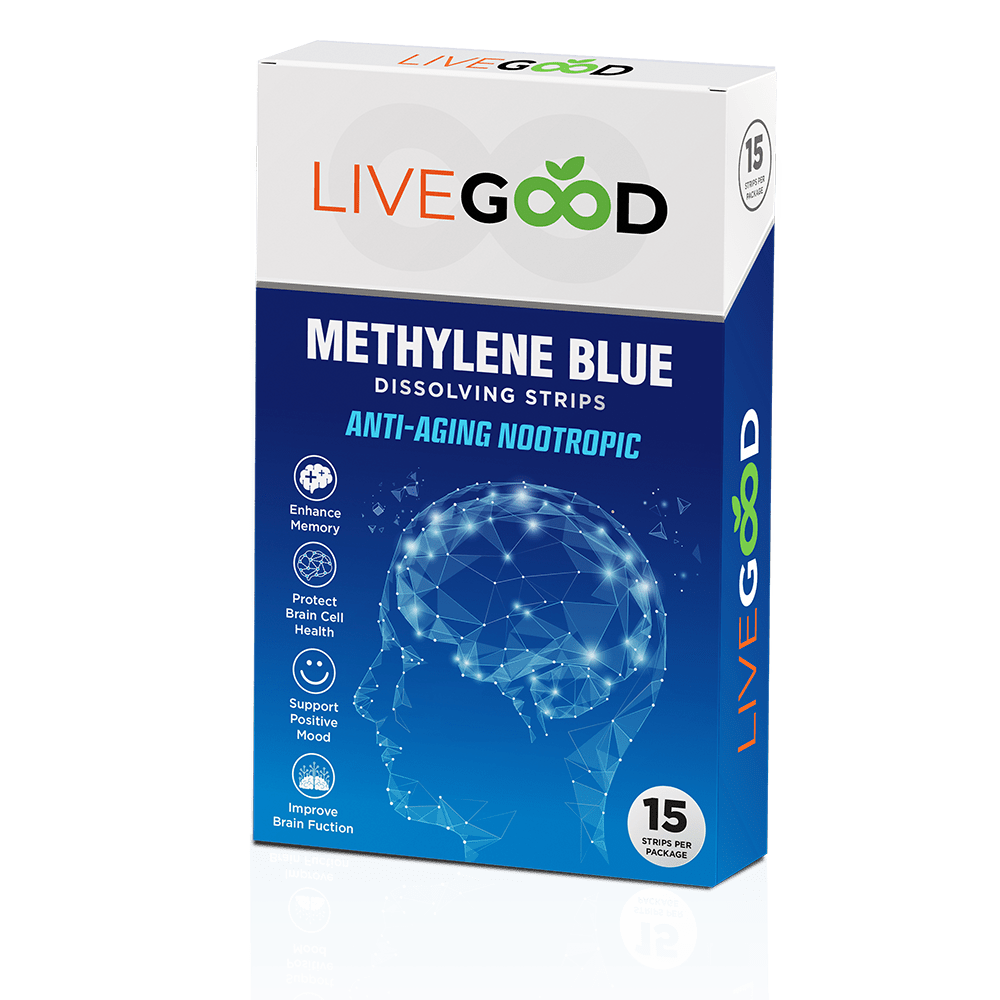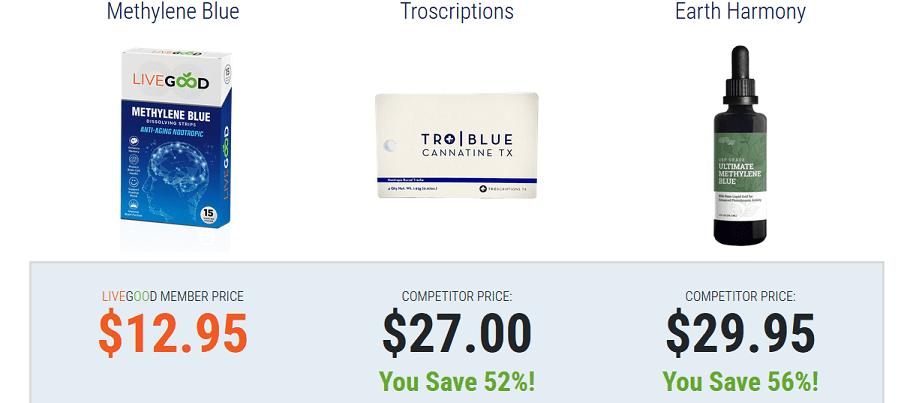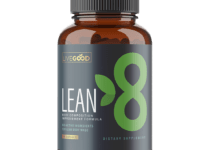A Guide to LiveGood Methylene Blue: A 19th-Century Dye with Modern Health Benefits
The Benefits and Origins of Methylene Blue

LiveGood Methylene Blue Introduction
I don’t know about you but up until about 5 months ago I had never heard of LiveGood Methylene Blue. I was intrigued so I went down the rabbit hole which is what led to this post. The color blue often brings on feelings of calm, depth, and mystery. Some use the color blue to announce “it’s a boy”. But did you know there’s a certain shade of blue with a rich history that can impact your health in profound ways? Meet methylene blue, the 19th-century dye turned treasure of modern-day health benefits.
Origins and Transition
Introduced in the 19th century by German chemist Heinrich Caro as a textile dye, methylene blue quickly captured the attention of scientists like Robert Koch and Paul Ehrlich. Recognizing its unique antimicrobial properties, they helped transition it from textile labs to medical clinics. By the onset of the 20th century, methylene blue was hailed as a groundbreaking treatment for malaria, a position it still maintains today.
Mechanism of Action
Methylene blue is, in essence, a redox agent. Don’t let the jargon spook you; all that means is that LiveGood methylene blue is a supercharger for your biology at the cellular level. When combined with other biohacking modalities such as infrared light therapy and hyperbaric oxygen, methylene blue becomes something akin to a cuppa coffee for your brain. Indeed, one physician cites research and says: “Methylene blue, in conjunction with red light therapy, is so effective at remedying hallmarks of dementia that some might even call it a cure.” Another doctor, Dr. Scott Sherr, discussed the marriage of methylene blue and hyperbaric oxygen in our podcast discussion.
LiveGood Methylene Blue Benefits
- Cellular Energy Production: Methylene blue donates and accepts electrons based on the needs of the biological process at hand. This ability to shuffle electrons makes it an integral part of several biochemical reactions, especially those involving cellular energy production.
- Cognitive Enhancement: While methylene blue typically enhances mental clarity, mood, and well-being, it has been shown to improve memory, enhance focus, and even combat symptoms of Alzheimer’s disease.
- Antioxidant Properties: As an antioxidant, LiveGood methylene blue helps protect cells from oxidative damage and reduces inflammation.
- Neuroprotective effects: Methylene blue offers strong neuroprotective properties. It helps lessen the buildup of harmful proteins, such as beta-amyloid plaques and tau tangles, known for their association with neurodegenerative disorders like Alzheimer’s. This protective feature may slow down the progression of such diseases and help maintain brain health. It has also shown promise in preventing neurodegeneration in the cases of traumatic brain injury and Parkinson’s via its mitochondrial effects.
- Enhancing Emotional Well-being: Methylene blue emerges as a beacon of hope for those struggling with emotional disorders. It enhances the efficacy of neurotransmitters such as serotonin and norepinephrine, which are crucial in the modulation of mood. This enhancement suggests that methylene blue has the potential to mitigate symptoms linked to conditions like depression and anxiety, offering a ray of light for improved mental health.
- Alleviating Discomfort and Reducing Inflammation: LiveGood methylene blue is gaining recognition as a powerful agent with antioxidant and anti-inflammatory capabilities. As an antioxidant, it combats detrimental free radicals that can cause cellular damage and lead to illness. Concurrently, its anti-inflammatory effects may regulate the body’s inflammatory processes, potentially decreasing the likelihood of chronic diseases that are linked to inflammation. This dual action positions methylene blue as a valuable ally in promoting overall health and wellness.
- Rejuvenation and Longevity: Methylene blue is emerging as a promising tool in the realm of anti-aging. It has been observed that mitochondrial dysfunction is a common thread in the aging process across various body tissues. Methylene blue has the potential to counteract this dysfunction. Additionally, it encourages autophagy, the body’s way of cleaning out damaged cells to make way for new, healthy ones. This process is crucial in slowing down the aging process and promoting cellular rejuvenation.
- Potential for Repurposing as an Antiviral for COVID-19: Methylene blue inhibits entry and replication of SARS-CoV-2, including several of its mutant variants, and has potential as a possible inexpensive, broad-spectrum, orally bioactive small-molecule antiviral for the prevention and treatment of COVID-19.
- Potential Inhibitor Against Many Viruses: Methylene blue is a potent inhibitor against Zika virus, Dengue virus, influenza virus H1N1 and SARS-CoV-2,

Cautions and Side Effects of LiveGood Methylene Blue
- Temporary Blue Discoloration: One quirky side effect of methylene blue is the temporary blue discoloration of urine and stool. Don’t be alarmed; it’s harmless!
- Gastrointestinal Disturbances: Some individuals may experience mild gastrointestinal disturbances.
- Rare Allergic Reactions: Although rare, allergic reactions are possible.
LiveGood Methylene Blue Usefulness
Methylene blue is FDA approved to treat a blood disorder called methemoglobinemia. However, it’s sometimes used off-label for other reasons. Its broad benefits for health make it a fascinating compound to explore.
Remember, always consult with a healthcare professional before incorporating methylene blue into your wellness routine. But rest assured, this 19th-century dye is still making waves in the 21st century.
For further reading, check out these resources:
- The Side Effects of Methylene Blue, How to Use it, & More1
- Methylene Blue: Uses, Benefits, and Risks2
Methylene blue, a compound with a fascinating past, has transitioned from a textile dye to a versatile chemical agent with significant medical applications. Let’s delve into its intriguing history:
Origins and Early Use
- Heinrich Caro, a German chemist, synthesized methylene blue in 1876 as an aniline-based dye for cotton. Its vibrant blue hue made it ideal for textile dyeing.
- In 1880, microbiologist Robert Koch established methylene blue as a medical stain. Its staining properties were invaluable for visualizing cells and tissues under the microscope3.
- Beyond textiles and microscopy, methylene blue found other roles:
- Indicator for Redox Reactions: It serves as an indicator in chemical reactions involving electron transfer.
- Photosensitizer: Methylene blue generates singlet oxygen, a reactive form of oxygen used in photodynamic therapy.
- Treatment for Methemoglobinemia: This condition arises from certain drugs, toxins, or broad beans. Methylene blue chemically reduces ferric iron in hemoglobin to ferrous iron, effectively treating methemoglobinemia.

Pioneering Medical Applications
- Paul Guttmann and Paul Ehrlich pioneered methylene blue’s use in treating malaria in 1891. Its antimicrobial properties made it a groundbreaking therapy during that era.
- By the early 20th century, methylene blue was hailed as a treatment for malaria, and its role in medicine expanded.
- World War I further highlighted its significance, as researchers like Ehrlich explored its potential.
Modern-Day Impact
- FDA-approved for treating methemoglobinemia, methylene blue remains a vital tool in medicine.
- While its textile dye origins may seem distant, this 19th-century compound continues to make waves in the 21st century, impacting health and well-being1.
Methylene Blue FAQ’s
Is methylene blue safe during pregnancy or breastfeeding?
- Do not use if pregnant or breastfeeding. It is essential to consult a doctor during pregnancy or while breastfeeding. Safety considerations depend on individual circumstances, and professional guidance is crucial1.
Remember to always follow your healthcare provider’s recommendations when using methylene blue. If you have any specific concerns, consult your doctor for personalized advice.
Are there any drug interactions with methylene blue?
- Yes, methylene blue can interact with certain medications, including:
- Serotonin reuptake inhibitors (SSRIs): Combining methylene blue with SSRIs can lead to serotonin syndrome.
- Monoamine oxidase inhibitors (MAOIs): Concurrent use can cause hypertensive crisis.
- Linezolid: Combining these drugs can also lead to serotonin syndrome.




One Comment